|
|
Welcome to my travel log! You will find here a lot more than in the travel reports, stripped from political correctness. Enjoy! 
Aug 30, 2004 02:00 PM Peru - Lake Titicaca; Uros and Taquile islands
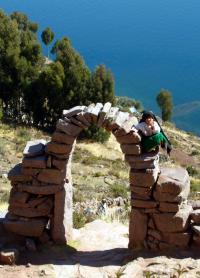 The Lake Titicaca (also spelled Titikaka) I chose specifically for the trip to ensure there is some nature involved during this holiday. Obviously I did enough reading around this subject and thought it would be a great idea. Well, it turned to be a good idea, at best.
The Lake Titicaca (also spelled Titikaka) I chose specifically for the trip to ensure there is some nature involved during this holiday. Obviously I did enough reading around this subject and thought it would be a great idea. Well, it turned to be a good idea, at best.
Lake Titicaca has very little to do with nature and a lot to do with mass tourism. Well, this is still a lake. I will say more – it is a natural lake. However, what is associated with it is little natural these days. It was more natural and less commercial, say, fifteen, maybe even ten years ago. Not anymore.
The trips, which the numerous agencies run out of Puno, are concentrated on specific items. Almost unfortunately so was my plan. These items are Uros, the floating islands, and the islands of Taquile and Amatani. I did want to see these and I most definitely do not regret that I saw them – that was an important experience of this holiday. Actually, due to time limitations (again!) I did not end up seeing Amatani, but maybe that was a good thing.
Let me take Uros islands and the island of Taquile in turn.
Uros, islands made entirely out of straw reed and floating in the lake, have been described by some as floating souvenir islets. I have to agree with that, I am afraid. The people who live on the islands are genuine, I am sure, and I am quite sure they live there, but what they are reduced to do and live on is the tourism. The entire show-off how they live is like a human zoo.
Furthermore, they embarked on building some completely dysfunctional structures of the reed only for show, including observation towers and boats that look like animals, which are purposely built for tourists. It is a shame. I was very disappointed, but then again I was actually one of them bloody tourists who so badly influenced these people lives. Shame on me, too? I guess so.
There was this little girl helping her mother sell some of the souvenirs. She was very sweet actually and she was also selling her own art. These were little drawings that she made – each costing one sol. I bought one of them and asked her to sign it for me like a professional artist would do. I did not actually believe she was old enough to be able to sign it but without a blink of an eye she took a pen I handed her and with one smooth movement she signed her name - . I was thrilled and genuinely impressed. Now, when I think about, this actually made my day that day.
Taquile island could be summarised with a quite technical term – a tourist trap. There are a few pictures around and postcards as well showing a stone arch standing on a slope facing the blue waters of the lake. This is how good it gets. There is absolutely nothing more to it at all.
Officially, it is a communistic island where all have to work and men are those who do the knitting, by the way. Then everyone is expected to share with everyone. This is of course according to the travel guide. But I got completely confused because there are beggars in the streets and how come? Should not everybody be equal and share with everybody? Something did not fit to the official description, methinks. A big fat lie in general, I conclude.
There is absolutely nothing on the island. The main square (guess what, it is called Plaza de Armas) is ugly enough and still the governor is constructing another ugly building there. I guess to keep consistently unattractive.
Nevertheless, that was a gorgeous day with blue skies and beetroot-red burning sun. The boat was low and lazy – to align with the altitude of 3960 m (12992 ft).
|
Aug 29, 2004 02:00 PM Peru - Puno and Slillustani
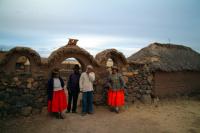 Puno, located at the very shore of Lake Titicaca, is not a particularly nice town. Even the Plaza de Armas is nothing spectacular. There is one street called Lima, which is pedestrians only and is packed with mainly shoe shops and eateries.
Puno, located at the very shore of Lake Titicaca, is not a particularly nice town. Even the Plaza de Armas is nothing spectacular. There is one street called Lima, which is pedestrians only and is packed with mainly shoe shops and eateries.
Otherwise, Puno is not very attractive and the diesel fumes do not particularly add any charm to it. The buildings are ugly and there is no ambiance in the city. It is a large urbanistic monster, which is very fortunate to find itself at the shore of the highest navigable lake on this planet. The lack of safety is another problem, which should not be taken likely in any circumstance. Ironically, the area around the lake is said to be the worst.
Tricycles are Puno’s only attraction. They are absolutely everywhere and are used to transport people, cargo, people with cargo or are used as a mobile shop offering anything from produce to hardware.
Sillustani, apart from the lake itself, are the closest traveller attraction. It is home to weird Inca-Kola structures designed to be tombs. They are actually considered the most complex structures the Incas ever built, so difficult that archaeologists struggle to reconstruct them.
The site is said to be situated in quite nice scenery but I've seen a lot nicer places on this planet. There is a nice lake there and there is a cool view from the top of the hill, which in fact is a cemetery, but everything looks empty and somewhat boring. Well, that was my impression, however I do admit that poor, or rather dramatic, weather might have clouded my impression.
I would also like to add that I would strongly recommend going there with a guide who is knowledgeable of the area, the history and the culture. Since I was lucky to come across a good guide, I did not regret going there.
What I found strikingly surprising was to learn that the Kolas and Incas mummified the dead like the Egyptians did. They had similar gods as well, at least one deity for every force of nature as well as the sun, the moon, the star constellations, and even the rainbow.
The area around Sillustani is very, very poor. This is the spot in Peru where weather gets very severe, particularly in the winter (exactly when I was there) with temperatures dropping 25 degrees Celsius below zero (-13F). There are no such things as heaters in the houses and the houses are actually built from mud brick, which provides for insulation but often the houses have no doors, and holes big like this do let the frost inside, I fear.
Many children in the area get very bad frostbite, which is clearly visible on their faces. This is possibly one of the saddest things I have seen in Peru.
Summers are not any better either. At altitudes reaching nearly 4,000 metres above sea (13,100 feet) the sun is very strong burning everything and everyone in equal measures. There is no escape. In fact, the sun burns all whenever the skies are clear – 365 days a year.
I myself got sun burnt while I was there and that was in the winter time. Then, in the evening, when thermometers showed less than 7C (44F), my face actually turned beetroot red for the first time in my life! Oh my, I seriously thought for a moment that it would stay like this.
Also, when one considers the altitude again, then there is not much that can actually be grown there from a farmer’s point of view. The sight and realising that people are genuinely surviving there somehow stuck me. That people build villages there. That they marry one another. That they choose to have families and children there. I humbly respect that. I bow.
During the escapade to Sillustani, I had a chance to visit a local household on the way. It was arranged with a genuine family, who was very hospitable.
The mother and the grandmother cooked some bread and cheese, which were delicious! They also allowed visiting the entire place.
I liked the little guinea pig farm behind the house. The little animals had their own miniature house and playground. Poor creatures were absolutely unaware that they were being grown for consumption purposes. I myself tried a roasted guinea pig back in Cusco, in the fabulous Mystique restaurant. It was good and it should be since it is Peru’s culinary specialty, locally known as cuy.
|
Aug 28, 2004 02:00 PM Peru - Machupicchu
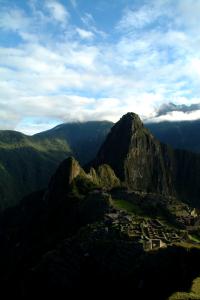 There is also a great view of Machupicchu (from where one cannot see the tourists’ bright jackets) from Intipunku (Puerta del Sol) up in the mountain to the east of the ruins. There is a very easy ascent from the ruins and there are many orchids on the way. In addition, you can meet two or three families of Llamas wandering around, biting and chewing on the orchids and the plants around the trail.
There is also a great view of Machupicchu (from where one cannot see the tourists’ bright jackets) from Intipunku (Puerta del Sol) up in the mountain to the east of the ruins. There is a very easy ascent from the ruins and there are many orchids on the way. In addition, you can meet two or three families of Llamas wandering around, biting and chewing on the orchids and the plants around the trail.
Intipunku (a restored ancient gate, part of the overall complex and sanctuary of Machupicchu) is actually the site from which the Inca Trail trekkers see Machupicchu for the first time as they come out from behind the mountain. It is a spectacular view, I have to admit. I admit and I hereby present a modest picture of it on this very page.
Aguas Calientes, the aforementioned, small and cheerful town is improving everyday. The scenery is amazing as the town is laid in between steep mountains. The place is also very relaxing and would be great for nothing-doing for a few days.
It has all the amenities for travellers. There are plenty of bars and eateries, which compete fiercely amongst each other. Particularly lunch time is the period of rivalry as the majority of travellers are up the mountain looking at the ruins. One of the restaurateurs almost begged me to lunch at her place.
Best dinner or supper food in town is at Indio Feliz, and it is a great pity they are not open during the day. The owners provide French food accompanied by music of Edith Piaf and this combination pleased my stomach immensely. The food is of top quality and the fireplace downstairs (which occasionally could be too smoky) adds to the ambiance brilliantly.
I almost forgot to say that Aguas Calientes, which means hot springs, has in fact a public pool with natural hot springs. I did not go myself, but I am sure it must be wonderful to soak for couple of hours in hot waters relieving aching bones tired from hiking in the mountains. Watching the surrounding mountains and stars above would definitely be my way of concluding the day.
|
Aug 27, 2004 02:00 PM Peru - Machupicchu and Aguas Calientes
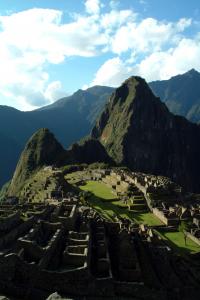 The sanctuary of Machupicchu is Peru’s most recognised site and naturally, it was the very primary or key destination in this country for me.
The sanctuary of Machupicchu is Peru’s most recognised site and naturally, it was the very primary or key destination in this country for me.
Questions, or rather fascination, were expressed how was it possible that this site was this much advertised throughout our planet and that almost everyone knows about it. I thought about it and it occurred to me that the Inca Empire was in fact once the largest empire in the Americas (both North and South combined) and Machupicchu was one of the key cities of the empire. That therefore deserves attention and appreciation.
For a number of years, there was a helicopter service to Machupicchu, but it was suspended indefinitely due to fears of resonance and turbulence it caused threatening the survival of the ruins. I think it was a good idea, however now it takes a lot longer to get to the site.
Then, of course, there was the famous Inca Trail, which has been so popular for decades. What is has been is trekking along the ancient Inca trail across and along the mountain range. In fact it was so popular that tourists were arriving in their thousands to do the trail, and the Peruvian government made a decision to impose limits how many tourists can walk the trail every year. This has been done to protect this historical monument but means that what had cost approximately USD20 for decades now costs from USD200 to USD400 depending on the tour operator. It is a rather burdening to a budget of an average backpacker.
There are still thousands of tourists wishing to the trail, at least one of its versions. There is a full four day trek, which is obviously the most expensive and must be booked weeks of not months in advance. But there are also three, two and one day treks. The latter two combine the train ride and trekking itself.
Train in fact is one of good alternatives of reaching Machupicchu, and there are variants of the train rides. There is the cheapest called Backpacker, and then a bit more expensive and more comfortable Vistadome and the very exclusive Orient-Express-like train named Bir Hakeim. The latter one is extremely expensive and costs around USD400 but includes dinner (ha!).
I decided already when reading my guide books that since the Inca Trail was so difficult to organise and was so expensive, I would opt for the train ride and then spend at least one night at the site so I could appreciate it during both sunset and sunrise.
The not-so-great thing about the train is that it departs Cusco almost in the middle of the night and one has to report at 5:30 in the morning. And there is only this early morning service – no chance to have the opportunity to travel in the afternoon.
The other thing is that the train is very slow and cold. The trip seems to be taking forever and the several zigzag switch backs of the train (or rather the direction of the ride) are tiring and slowing things down considerably.
In the morning, there is a simple service on the Vistadome train with a hot beverage (coffee, tea or mate de coca) and a bread roll with cheese.
The afternoon, back to Cusco service, does not serve coffee but it does a show! It stars with an artistic show illustrating local dance and dress. Then, it turns into a fashion show when the train personnel models to sell alpaca products – like pullovers, coats, scarves, jumpers, and cardigans.
Apart from that, the train trip provides some nice views of the mountains, which often snow-peaked loom through the roof windows.
The actual site of Machupicchu is located among very impressive scenery but the site itself appears slightly over-advertised.
Once you reach Aguas Calientes (a little town closest to the actual ruins) on a train, there is still quite a hike to make for the Machupicchu ruins. It can be completed entirely on foot or partially by a local bus and then on foot.
The ascent on foot from Aguas Calientes is rather tiring and should never be done around noon – in full scorching sun and no particularly nice views on the way. In addition, there are several road crossings to make and buses spread plenty of dust.
Well, this is what I did and I do not recommend this option for the middle day hike. I am sure it is very pleasant early in the morning when it is cooler and the buses are less frequent.
Once up there, the scenery strikes! And the fact that mobile phones work there strikes equally.
The number of tourists, which is the largest in the midday after all trains arrive, does not surprise much anymore, and yet the colourful clothing dotted around the site does not please photographers at all. Enough said!
Setting sun gives the best light for the site – this is the one on the tile page – and makes wonderful shadows amongst the ruins. This is the time also when there are much fewer tourists (and their colourful jackets) around – prefer time for taking pictures. Unfortunately, the site closes soon after sunset and there is little time to contemplate.
|
Aug 26, 2004 02:00 PM Peru - Pisac & Cusco
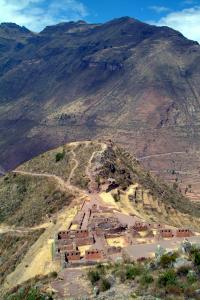 Pisac, another site of Inca ruins competes successfully with Machupicchu and I would say I prefer Pisac. There are a few reasons why.
Pisac, another site of Inca ruins competes successfully with Machupicchu and I would say I prefer Pisac. There are a few reasons why.
The site in Pisac is actually a number of smaller sites linked together by ancient trail. I spotted four different sites, almost like separate villages or fortresses, because of their locations on the top of the hills. This makes it a great hiking place.
The construction of the buildings and structures was a lot more complex and these ones in Pisac are a splendid example how neatly the stones were carved to fit perfectly together. In Machupicchu there is only one wall with perfectly laid stones – all other buildings are not so neat.
There are much fewer people around and although the scenery is not as fabulous as around Machupicchu, the Pisac valley is great and there are some incredible views from the ruins.
My judgement could however be impaired by the fact that at Pisac there was a young man playing pan flute, which made it an unforgettable experience. Music travelled far in the valley visiting the nearby mountains one by one.
On the trail from one site to another, there is a small tunnel that needs to be taken to get to the other side. It is funny, because upon entering the tunnel one is not sure how long and how narrow that tunnel is, and how dark it is inside. This gives a bit of a thrill and is pleasant, particularly when at the other end there is a magnificent view.
There was a Peruvian man sitting at the other entrance of the tunnel, who was selling a local artwork. Considering that he had to get there, and that it was a long, long hike from the nearest village, and that it was relatively early in the morning, I decided to buy something from him.
The modern town of Pisac itself is minute. It has a colonial flavour and single storey architecture, and very narrow cobbled streets. There is also a cute little square, of course named Plaza de Armas, with an interesting church at one of its sides.
The plaza is unfortunately packed with market stalls filled with low quality items aimed at tourists. Although I am told it is also an important genuine market.
Back in Cusco...
Bars in Cusco are in large numbers. There is a lot of choice and many of the places are very atmospheric. All of them sell pisco sour and mate de coca.
Mate de coca is nothing else but hot water poured on either dried or fresh coca leaves. This beverage is believed to help people overcome the negative effects of high altitude. Coca leaf is also a crucial ingredient of cocaine, a dangerous and bad narcotic. Coca leaves on their own, do not contain any addictive or dangerous elements, however. To make cocaine, a specific chemical process has to take place, which is rather complex and involves adding a lot of other ingredients to the coca leaves.
Nevertheless, it is absolutely forbidden by law to import coca leaves to any country on this planet other than Peru, Bolivia, Ecuador and Argentina (I think).
Fascinating element of Cusco (and actually of many other cities of Peru) is the incredible number of shops with shoes. Shoes only! It looks like the Peruvian do not buy anything else but footwear. Then, of course you have an uncountable number of shoe cleaners in the streets hunting their prey without looking in the eye.
The very unfortunate characteristic of Cusco is traffic, which is unbelievable. Not only does the altitude kick in quickly giving you a slight headache but also the diesel fumes are horrible and contribute to your overall unwellness. Fortunately, one acclimatises to the altitude and the headache disappears, but the fumes remain and are difficult to forget for days.
|
Aug 25, 2004 02:00 PM Peru - Cusco; arrival and quick look in the area
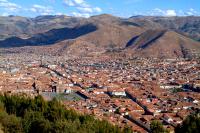 Early start in the morning was necessary to ensure getting on one of the twelve planes leaving for Cusco at 6 am.
Early start in the morning was necessary to ensure getting on one of the twelve planes leaving for Cusco at 6 am.
As I was collecting the tickets at the airport right after landing from Sao Paulo, I was told about the twelve planes and having to be at the airport two hours before departure but I thought the gentleman meant twelve planes leaving to all sort of directions.
I actually did not realise there would be twelve planes to Cusco alone and some other morning planes to other places in Peru. The domestic airport looked very busy filled with all those people who had to get up from their beds before they could reach their deeper levels of REM in their sleep.
As we finally got onto our aircraft, we soon had to change it. As it still stood on the airport. This was announced to be due to a maintenance error.
What actually happened was that the people, who were on the airplane we actually went with to Cusco, were put on the plane we thought we were actually going with. Some sort of maintenance problem?
Cusco
The ancient capital of the Inca Empire came as a surprise to me. The city is truly magnificent. It is quite large and combines both the Inca and Spanish colonial architecture, which makes a fabulous combination.
Stones perfectly laid by the lncas centuries ago are visible everywhere on the streets and buildings even inside restaurants like Mystique. This indicates perfectly that the city is in fact the very site from where this outstanding empire was administered. There are kilometres of walls, which combine the ancient and the modern techniques of erecting buildings.
The Spanish however, left an extremely attractive Plaza de Armas. The plaza today appears quite large with plenty of room for a central recreational area with a fountain, pedestrian space, greenery with flowers and benches to sit on. However, it is actually taking up only two thirds of the space, which originally was the central city square when the Incas ruled.
Cusco, as a whole, has fantastically preserved colonial architecture with distinctive houses and characteristic wooden balconies. They all look great during the day, but at night, they make even more powerful impression. They are tastefully lit and the street lights play with the scenery very cleverly.
There are also a number of interesting Inca sites around Cusco. One of them is Sacsayhuaman. It is located on the hill overlooking the capital. It is quite impressive but not overwhelmingly. There is simply too little left of the ruins.
However one with good imagination can see how great the entire structure must have once been. It is one of the better places to see to what perfection and precision the Incas were carving the stones for their buildings and structures. It must have taken a lot of effort to carve every single stone to fit exactly to another. Plus, the stones were carved to lay in a way to ensure the structure stands earthquakes and one of their features was the edges were rounded.
Sacsayhuaman (often pronounced by foreigners as ‘sexy woman’) offers also a magnificent view of Cusco right from the main ruins site and also from the place where a large white figure of Jesus Christ stands.
On the hill, right by the ruins, there are groups of people from local villages posing for photographs. It actually costs to take pictures of them and the fee is flat in the entire Peru and amounts to one Nuevo sol, which is about USD 0.30 or EUR 0.25.
I would normally not support this, but many of these ‘models’ are children and in a country as poor as Peru, I guess it does not harm to give them some money so they can support their families. There are many models, many well overpaid, who receive remuneration for being taken pictures of. How would this therefore be different from people asking for a small fee if you take a picture of them?
One does not however need to go as far as Sacsayhuaman to see people dressed in traditional clothing though, as Cusco is full of people wearing their traditional outfits everyday. This is just how the people dress in Peru, particularly in the highlands.
One thing that I want to mention is that Cusco gets really cold at night. It seriously gets cold enough to wear woollen hats, scarves and good pair of gloves.
This may surprise a few readers since Peru lies in the tropics, but in the mountains at approximately 3,500 meters (11,500 feet) above sea level it should not be a surprise at all.
I very much experienced this bitterly coldness but no for too longer moments, though. The problem (not a problem really) was that I did not stay long at night because of the very early morning getting up for the following day extravaganza. Otherwise I would have stayed in bars and mingle with the locals and fellow travellers, who flock to Cusco like flies to hmmm… that would not be an appropriate comparison.
Well, the problem was the altitude, which does not necessarily facilitate drinking alcohol, including beer. What I mean is that one has to be very careful when drinking at these altitudes, where the air pressure provides for additional boost in the head making the drinking sessions not only a lot more economical but also quite dangerous if one forgets how much can be drunk at the level of 11,500 feet above the sea.
|
Aug 24, 2004 02:00 PM Peru - Lima
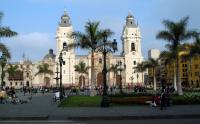 The taxi drove through the city in the beginning and then turned onto the ocean front highway right to the district of Miraflores, where the free night at DoubleTree Hotel (part of the Hilton family) was waiting.
The taxi drove through the city in the beginning and then turned onto the ocean front highway right to the district of Miraflores, where the free night at DoubleTree Hotel (part of the Hilton family) was waiting.
A shower in a five star hotel after a long trip is always invigorating. So is the complimentary welcome drink in the hotel bar.
The welcome drink was, of course, Pisco Sour – a local invention. It contains 3oz of Peruvian Pisco, 1oz of fresh lemon juice, 1oz of white sugar or plain syrup and 0.25oz egg white. This is mixed with 4-6 ice cubes and is delicious. It is very often served with a few drops of Angostura bitter. The drink is really nice and strong. It tastes similar to Margarita based on Tequila because of the large amount of lemon juice and the taste of Pisco. Why could I not resist the urge to give this recipe here?
Miraflores is a very nice district of Lima. It is fully civilised, relatively clean and safe. Modern offices, hotels, casinos, restaurants and other public buildings as well as magnificent villas and haciendas of the wealthy Peruvians dominate the architecture of Miraflores.
The old town is however a lot nicer, although not necessarily safer. I should say that the old town is gorgeous and the main square, which is called Plaza de Armas (almost any other town or village in Peru has one with the same name), is absolutely spectacular.
This is what UNESCO have put as a description of Lima on their website, which is in fact an explanation why Lima deserved to be inscribed already in 1988 and then again in 1991:
“Although severely damaged by earthquakes, this 'City of the Kings' was, until the middle of the 18th century, the capital and most important city of the Spanish dominions in South America. Many of its buildings, such as the Convent of San Francisco (the largest of its type in this part of the world), are the result of collaboration between local craftspeople and others from the Old World.”
Plaza de Armas is a very good example. At one end, it has a palace. At the other – a cathedral and the other two – big yellow buildings with arcades and brown balconies. Wow!
In the centre there is, of course, a fountain, which in Lima was also and unfortunately dominated by the filthy pigeons.
At that time, the central part of the plaza was also dominated by a group of schoolgirls, who were making interviews with the pedestrians to their school newspaper. The funny thing was that although they tried, they could not speak much English. The conversation was therefore hilarious. It included the following:
- Do you like Peru?
- I do not know yet, I literally arrived a few hours ago.
- Oh, really? What did you like the most?
The time was flying. It is always flying faster in places closer to the equator since the day is not very long. It was about to get dark very soon. There are many places around the old town of Lima, but it was simply unrealistic to see much because of the limited time and following a person, who was not very fluent in reading maps and directions.
In Lima, directions are important because the city is more than huge with an uncountable number of inhabitants – various sources stating approximately nine million, but no-one really knows. The city is also full of extreme contrasts and one can find oneself suddenly in an unsafe area within minutes from a beautiful district.
Taking a taxi is therefore a routine. Interestingly, as we were waiting on the corner of one of the plazas to get a ride, one and the same taxi, to which we said no at the airport, stopped and took us back to Miraflores. In the huge, nine million inhabitant city like Lima, I call it an incredible coincidence! What would you call it exactly?
Although Lima was never at the centre of this holiday, it is a pity I could not explore it more – at east for a full day. The other time limitation was caused by a short evening due to a very early start the following day. The day was actually started in the middle of the night – right at 4 am.
|
Aug 23, 2004 02:00 PM Peru - Flying out
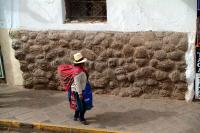 Getting to Peru could not have been easier. It was a single phone call away. I just needed to call Star Alliance and ask for a free ticket. It was brilliant! With Star Alliance it does not matter how many times one needs to change planes on the way to the final destination. The ticket costs the same amount of air miles regardless if is a direct, non-stop or many stops flight(s). This time it was with Varig, Brazil’s national carrier.
Getting to Peru could not have been easier. It was a single phone call away. I just needed to call Star Alliance and ask for a free ticket. It was brilliant! With Star Alliance it does not matter how many times one needs to change planes on the way to the final destination. The ticket costs the same amount of air miles regardless if is a direct, non-stop or many stops flight(s). This time it was with Varig, Brazil’s national carrier.
The Sao Paulo airport was the airport where the stop was, and it was considerable because it was for approximately four hours. With access to the club lounge however, it is a laugh. Free food and free drink with no limits – this is what I call quality holiday travel. Well, I could not get sloshed because it was rather early in the morning the local time and it would look very awkward if suddenly started to drink like I have never seen alcohol before.
There is a slight problem with Sao Paulo airport – one needs to go round the airport just to change the gates from one plane to another, and the lounge is before the metal detectors.
Uh, I forgot to say that on the way to Sao Paulo I had an entire row of four seats to myself. I had a very good night sleep in an absolutely horizontal position. Exactly the same way I had on the way to Madagascar with South African Airways, soon member of Star Alliance, too.
The last leg of the journey to Lima was operated by a small Boeing aircraft, which was able to fly all the way across the continent - 2161 miles (3478 kilometres).
I was impressed.
The view from the airplane also impressed me. Particularly the Cordillera of the Andes! I did not at all expect to take some fantastic pictures from the airplane! It is important to sit on the right side of the plane for the best views. The views were very important for the flight, which felt like it was taking a week!
That was my first encounter with Varig and I have to say I was pleasantly surprised. I liked the friendliness, professionalism and relatively high standard. It was also clean and the food was good. I cannot comment on the entertainment programme because I nicely slept through it all…
After landing in Lima (very strangely (dis)organised airport), the plan was to try to retrieve the tickets for the internal flights. They all were with Lan Peru but I simply could not find the ticket desk. I asked and asked and asked many ‘official’ people at the airport, but they were all giving contradictory directions. The problem was that there is no Lan Peru ticket desk at the airport. The tickets are actually issued at the check-in counters. And one would know that how?
Well, it is theoretically possible to buy Lan Peru and other airlines’ tickets at the front of the airport building, from a suspiciously looking hole in the wall, but ladies in the hole, of course, did not deal with tickets pre-paid and/or reserved via the Internet.
So, after spending unnecessarily about 45 minutes on the impossible task to find a ticket desk, the time has come to go and check the UNESCO listed capital of Peru.
Ah, actually, before that time, there was a time to get a ride to the town. Getting a decent taxi from Lima airport is a mystery and one has to make a difficult decision whether to get an official and overpriced taxi, or a dodgy, unofficial one. I personally think it is better with the official one. How much overpriced can it be? By 5 US dollars?! I think I can live with that, and so can the poor family of the taxi driver, I am sure.
Yet, it was not good enough for some of us in our group to pay a little more and so we went on chasing a private taxi just outside the main parking area. Soon, we discovered that a private taxi wanted a very similar amount like those ‘official’ ones. To that we said no. There was nothing lese to do but to change ‘our’ mind and to try to ride with one of the drivers who approached us previously. Nevermind of wasting some time, one can imagine how pleased I was with that!
|
Aug 22, 2004 02:00 PM Peru - The last minute planning...
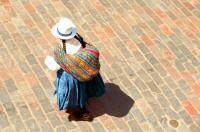 Peru does not always seem as a ‘must’ destination and yet it has always been on my mind. Perhaps this is the Incas and the magnificent empire they were able to build. Perhaps, this is the pyramids of the Chimu civilisation most of which still need to be excavated. Perhaps this is the Nazca Lines that remain one of the greatest mysteries of this world. Or, this is the astonishing beauty of the second tallest mountains on this planet – the Andes.
Peru does not always seem as a ‘must’ destination and yet it has always been on my mind. Perhaps this is the Incas and the magnificent empire they were able to build. Perhaps, this is the pyramids of the Chimu civilisation most of which still need to be excavated. Perhaps this is the Nazca Lines that remain one of the greatest mysteries of this world. Or, this is the astonishing beauty of the second tallest mountains on this planet – the Andes.
Whatever this is, I was finally there to see it for myself.
There was one thing that I did not expect and that was the magnificent colonial architecture of the towns such as Cusco, Arequipa, Trujillo and even Lima.
Planning the trip has taken years. Literally. One of my guide books was eight years old. I started planning to Peru back in 1999. Or, even earlier! I managed to draft a plan using Microsoft Excel. Then, I was planning to go to Peru for at least a month. Back then already did a lot of reading about the country and I found out about the different cultures. It wasn’t any easy task to fit all attractions in to one go.
I remember that I spent a month planning everything. I read the books and surfed the Internet trying to create a perfect itinerary. Now, I understand why you have to pay for such an itinerary if you found one on the Internet. It takes a lot of energy to create one.
So, I thought it would be easier this time. I couldn’t be more wrong. Somehow, it proved to be a challenge to fix everything into two weeks this time round. Was it a surprise? I guess not. I still wanted to see everything. Well, it wasn’t so bad. I only had to resign from one site on the northern coast – Chiclayo. If I remember well, I wasn’t actually planning to do much hiking in the Andes back in 1999, but after seeing so many beautiful pictures on the Internet and just decided to go there as well. And it was a good decision.
So, there I am in the beginning of 2004 and again planning a trip to Peru. Having just come back from Indochina I knew this one was not going to be as good, but the plan had to be as good as it could get. It had included all the major sites of Peru and yet allow for a contingency to see some extra places recommended by people met on the road. That was really important, as no-one wants to lock oneself out of any other options.
I have to say that I mastered the use of Excel in creating various options of the itineraries. I only had to do three versions of this Peru trip. The sensitivity was around the time to spend on the travel to the ruins of Machupicchu.
Originally, I thought I wanted to do the Inca Trail for four or three days, but as I mentioned earlier I had old guidebooks, which did not mention that the Inca Trail has been ‘censored’ and only a given number of tourists can do the trail. This now involves booking the hike well in advance with a tour operator and cost at least 10 times more. This was one thing that had to be flexed.
The other element was the bus travel. How long can a person (who loves clean bathrooms and a shower at least once a day) live without having a shower? Therefore, most of my time spent on creating the plan was to browse the Internet looking for various options and timetables of local airline companies. It eventually was not that hard at all.
|
Jun 18, 2004 02:00 PM USA; Texas - Houston, the Space Centre
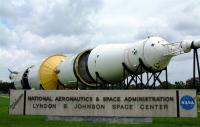 So, Texas is famous for the food, but Houston is even more famous because of the National Aeronautics And Space Administration’s (NASA’s) Lyndon B. Johnson Space Centre, which expedited the man to the Moon.
So, Texas is famous for the food, but Houston is even more famous because of the National Aeronautics And Space Administration’s (NASA’s) Lyndon B. Johnson Space Centre, which expedited the man to the Moon.
I therefore went to see it, but I was keeping my hopes on a leash, as I knew that the director has got a tendency to exaggerate and blow things out of proportion. I multiplied this parameter by the usual kitsch factor, which is always present in very American places like that.
And…yes, it was a bit disappointing. The expositions inside the tourist part of the centre were plastic-fantastic and completely unrealistic. The plastic kids train I was then taken on for the tour around the property was over engineered and superficial. I might have seen or be shown the legitimate hangars and training rooms for the astronauts, but because it was so artificial, it all lost credibility. I was sorry, because I am a great fun of cosmos.
Texas, being the largest state in the United States of North America (Texans still consider Alaska an alien state), must be contributing the largest amounts of car fumes to the atmosphere. This is facilitated by the fact that the only macho vehicle to drive around Texas is a gigantic pick-up truck, which consumes more gas an hour than Cuba does in ten years. Yes, I am exaggerating here!
As soon as you turn the key in the ignition of one of those ‘baddest’ vehicles, a hyper-fast whirl in the tank becomes sucking the gas down the engine’s pipes. It is expected of every Texan man to drive such a monster. Plus, it is strongly recommended that visitors to the state rent similar vehicle or they risk a severe ridicule.
It is sad that it all affects the environment, and ultimately everyone on this planet, but what can you expect from Bushs’ oil state? Oops, I am not politically correct here! Or am I?
|
Page:
 93 94 95 96 97 98 99 100 101 102 103
93 94 95 96 97 98 99 100 101 102 103

|
|
|
